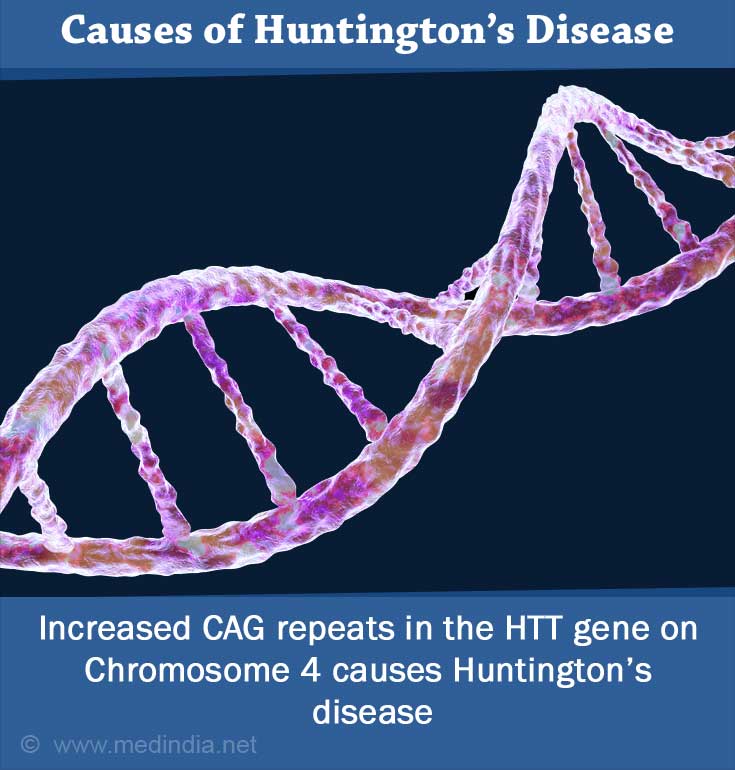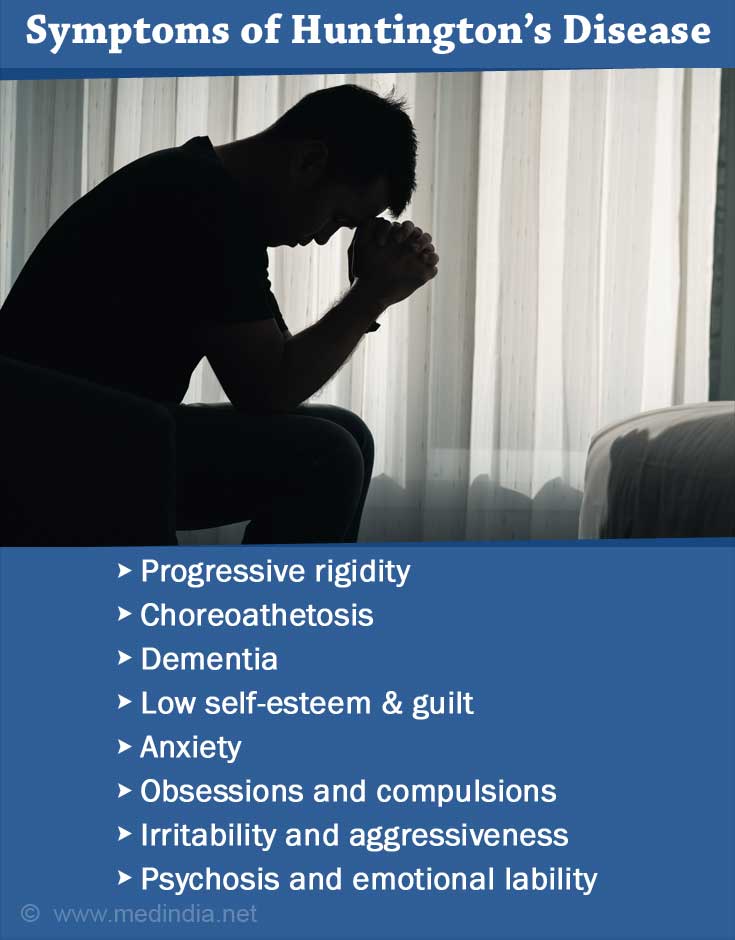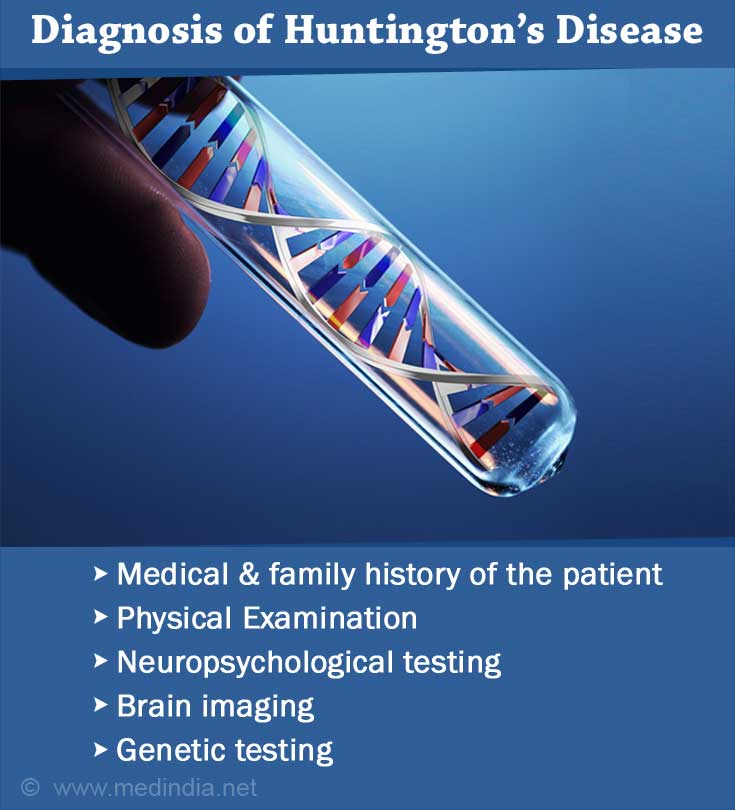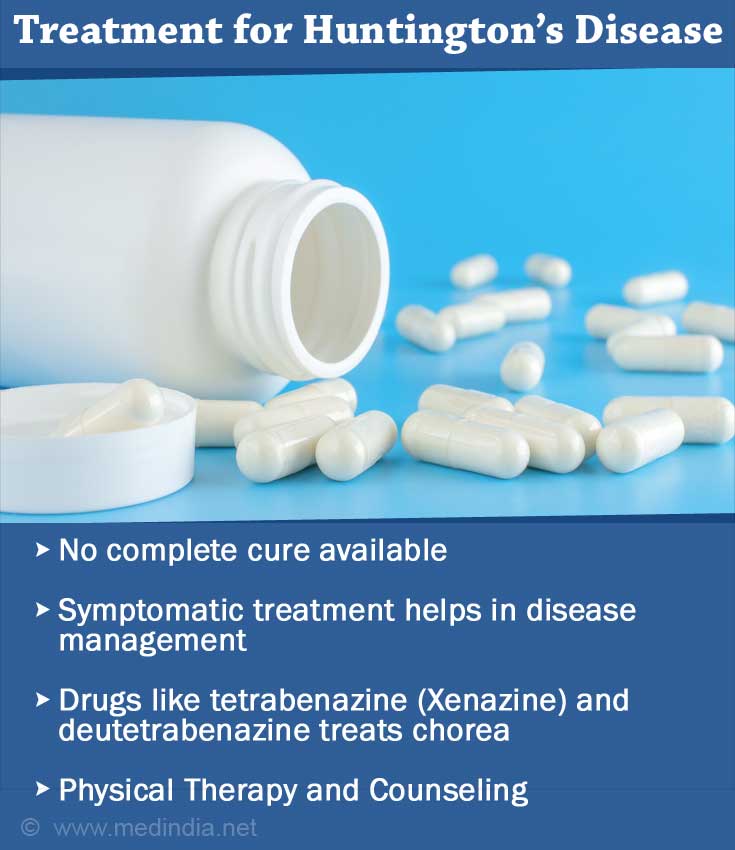- Huntington's disease: a clinical review - (http://www.ojrd.com/content/5/1/40)
- Huntington's Disease Information Page - (http://www.ninds.nih.gov/disorders/huntington/huntington.htm)
- Huntington disease - (http://ghr.nlm.nih.gov/condition/huntington-disease)
What is Huntington’s Disease?
Huntington’s disease is a rare progressive genetic degenerative disorder that affects the nervous system. Huntington's disease affects brain cells, called neurons and this degeneration affects the whole brain, but certain central area of brain called basal ganglia are more vulnerable than others.
The degeneration causes movement disorder (uncontrolled movements or Chorea), loss of intellectual faculties (cognitive defects), and emotional disturbance (psychiatric symptoms). Finally, it leaves the patient completely dependent on the caregiver. The severity of symptoms varies among affected individuals.
Huntington's disease was first described in 1872 by Dr George Huntington and it affects men and women equally across all ethnic and racial lines. It is more common in adults than children.
A research carried out in the UK in 2012 found that 12 people per 100,000 are affected by Huntington's disease or which is approximately 1 in 10,000 people. However twice this number have the gene but are not affected by symptoms. The disorder appears to be less common in some non-white populations, including people of Japanese, Chinese, and African descent.
What are the Causes of Huntington’s Disease?
Huntington’s disease is a genetic disorder. The genetic defect is ‘increased CAG repeats in the HTT gene on chromosome 4.’
Our DNA contains some segments that have the sequence of the building blocks cytosine-adenine-guanine (CAG) repeated, usually 10 to 35 times. For diagnosis of Huntington’s disease, there should be CAG-repeat of at least 36 in the HTT gene on chromosome 4.
The increased number of repeats result in an abnormally long huntingtin protein, which breaks into smaller fragments and accumulates in the brain cells, disrupting their function and causing symptoms and signs associated with Huntington’s disease.
Higher number of repeats is associated with earlier onset of disease. Patients with juvenile Huntington’s disease usually have 60 or more CAG repeats in the HTT gene. A low number of repeats around 35 to 39 can result in the disease appearing very late, or even not appearing. However, it can still be passed on to the child if the child develops more repeats.

The mode of inheritance of Huntington’s disease is autosomal dominant.Thus, even if a person has only one chromosome 4 defective from the pair of chromosomes 4, the person is likely to manifest the symptoms. The child has a 50% chance of inheriting the defective gene if one parent is affected.
What are the Symptoms of Huntington’s Disease?
Symptoms of Huntington’s disease usually appear around middle age, though cases in children as well as older individuals have been reported. Juvenile Huntington’s disease is characterized by the appearance of symptoms before the age of 20 years. These patients have behavioral symptoms, learning disabilities and epileptic fits.
The severity of symptoms varies among individuals and include:
- Abnormal movements: The characteristic sign of Huntington’s disease is involuntary movements especially in the fingers, toes and facial muscles. These movements are called chorea. Huntington’s disease is also sometimes called Huntington’s Chorea as the movement appears like a dance ("Chorea" is the Greek word for dancing.) However chorea is also seen in other neurological conditions. These are noticed when the patient is awake. Movements of the facial muscles include involuntary lifting an eyebrow, closing an eye, pouting of lips etc.
As the condition worsens, other muscles also get affected. Involvement of the throat muscles can cause difficulty in speaking and swallowing. Movements become slow and the patient appears rigid. Abnormal tone of the muscles can cause torticollis (condition due to spasm of the neck muscles) or abnormal postures. Tics may be present. The patient walks with an unsteady gait and may suffer from frequent falls.
In the later stages, the patient might find it difficult to carry out activities of daily living.
- Psychiatric disturbances: Psychiatric symptoms include feeling of depression, low self-esteem, guilt, anxiety, mood swings, obsessions and compulsions, irritability, and aggressiveness. Psychotic symptoms like hallucinations may also occur. The risk of suicide is high in these patients.

- Cognitive decline: Cognitive decline is observed in patients with Huntington’s disease. There are problems with perception, awareness, thinking and judgement. Dementia or forgetfulness is common, though it may be mild in some patients. Patients slowly lose their ability for judgement, planning and mental adjustments.
Other symptoms include weight loss, sleep disturbances and sweating attacks.
The stages of Huntington’s disease patients can be divided into two:
- Preclinical stage: In this stage, the patient does not suffer from the condition. However, he is aware that his family member has the condition and he is also likely to suffer from it. He may even get a gene test done, which may confirm the presence of the defective gene. Some changes may be noted, but the patient is still uncertain of what will ensue.
- Clinical stage: The clinical stage is characterized by the appearance and progression of symptoms. The patient is initially independent, but as the condition worsens, is completely dependent on caregivers.
How to Diagnose Huntington’s Disease?
Huntington’s disease is diagnosed based on the family history of the patient, genetic testing and the presence of physical symptoms. In many cases, some member of the family already suffers from the disease and the patient gets a genetic testing done. Thus, once the symptoms start manifesting, the condition is easy to diagnose.
The severity of the disease can be studied using several scales. MRI may show a decrease in brain volume, but this test is not necessary for the diagnosis.

How do you Treat Huntington’s Disease?
Though Huntington’s disease cannot be cured, there are several drugs, which can be used to treat the symptoms and provide some relief to the patient. Some of these are listed below:
Drugs used to treat chorea or abnormal movements include:
- Tetrabenazine – It is the first drug to be approved in the United States for Huntington’s disease per se.
- Tiapride
- Olanzapine
- Pimozide
- Risperidone
- Fluphenazine
Drugs to treat depression include:
- Citalopram
- Mirtazapine
- Fluoxetine

Drugs used to treat aggression include:
- Citalopram
- Sertraline
- Olanzapine
- Haloperidol
Other therapies like physiotherapy, occupational therapy or speech therapy may be of use depending on the symptoms.
Huntington’s disease is progressive, and finally culminates in death. Death is commonly caused by pneumonia. Suicide is the second most common cause of death in these patients. Life expectancy is around 17 to 20 years after the diagnosis is made.
The only way to prevent Huntington’s disease is by genetic counseling. Prenatal diagnosis can be done during early pregnancy if the parents want the option of terminating the pregnancy if the child has the gene.
Health Tips
Since Huntington’s disease cannot be prevented or cured, there are no health tips that can be offered to the patient. The caregivers however are advised to join support groups where they can share their experiences and resolve any issues in the care of the patient.







